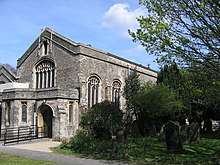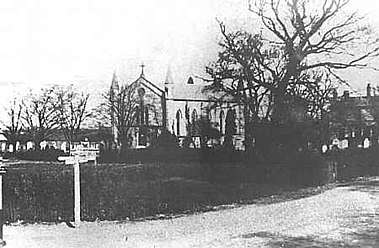St John's Church, Newland
St John's Church, Newland, also known simply as St John Newland, is an Anglican evangelical church located in the parish of Newland in the city of Kingston upon Hull, England.
| St John's Church, Newland | |
|---|---|
| Saint John Newland | |
 | |
| Location | Kingston Upon Hull |
| Country | England |
| Denomination | Church of England |
| Churchmanship | Conservative evangelical |
| Website | www.stjohnnewland.org.uk |
| History | |
| Status | Vicar |
| Consecrated | 23 September 1833 |
| Architecture | |
| Functional status | Active |
| Heritage designation | Grade II |
| Designated | 21 January 1994[1] |
| Administration | |
| Diocese | York |
| Clergy | |
| Archbishop | John Sentamu |
| Bishop(s) | Alison White |
| Vicar(s) | Melvin Tinker |
History
The church was built by Avison Terry, a leading evangelical layman and prominent citizen of Hull who was twice mayor (1827 and 1829[2]) and once Sheriff (1813) of the city. He raised public subscriptions to pay for the construction on a site close to his home of Newland Grove at a cost of £1,650. The church was consecrated by the Archbishop of York on 23 September 1833.

The original building was of a simple box construction with a balcony at the rear. It could house a congregation of around 500, which at the time was about the population of the local area, although average attendance was closer to 100.
Initially, Saint John’s was a daughter church to Saint Mary’s in Cottingham, and services were held on Sunday afternoons to accommodate the ministers’ schedules. Avison Terry, not being satisfied with this less than ideal arrangement, set out to raise further money so that St John’s could have a minister of its own. In October 1862, The Reverend John Pickford was selected by Reverend Charles Overton of St Mary’s Cottingham. In 1863, the vicarage at St John’s was completed, as well as a parish school, again by funds raised by Avison Terry.
Avison Terry died in 1866,[3] and was buried in the vaults which then existed beneath the church. Later modifications to the building removed the vaults and his grave is now found in the churchyard close to the south side of the church building.
In 1881 the Reverend Joseph Malet Lambert was appointed vicar of Saint John’s, and remained with the church for 30 years. He was instrumental in expanding the original building and added the chancel to the east in 1893.[4] In 1902 more significant works were carried out, extending the nave westward, removing the balcony and adding a north aisle separated from the nave by an arcade of six stone arches. The burials in the vaults were removed to the churchyard and the floor level lowered, and the windows changed from a tall narrow design to wider arched structures.
A creche and office rooms were added to the west end in 1958, and the exterior of the building remains much as it was then.
In 2013, the fixed pews were removed and the seating arrangements turned 90 degrees. A screen, projector, cameras for streaming the services[5] and a new sound system were installed blending the original architecture with 21st century congregational needs and evangelical belief and practice.
Present day
The present day incumbent, the Reverend Melvin Tinker, was installed as Vicar in 1994. He was one of the founding members of the Evangelical group REFORM and is a well-known international speaker and author.[6][7]
The church of over 500 people (including 100 children) is known for having a strong Bible expository ministry and has developed various evangelistic tools to foster Gospel outreach.[8][9] The congregations are multi-ethnic and diverse in composition with a vibrant student work linked to the neighbouring Hull University. The leadership team includes two associate ministers, the Reverend Scott Mackay and the Reverend Peter Birnie.
The parish church of St John’s has the daughter churches of St Faith’s, Dunswell, and Riverside Church expressing the vision of being ‘one church- multiple congregations’.
St John’s has connections with REACH South Africa, George Whitefield College in Cape Town, Champion Forest Baptist Church in Houston, Texas, and the Lanier Theological Library, Houston, Texas. It is also a member of GAFCON.[10]
References
- Historic England. "CHURCH OF ST JOHN NEWLAND (Grade II) (1208299)". National Heritage List for England. Retrieved 14 February 2019.
- "Search results | Hull History Centre". www.hullhistorycentre.org.uk. Retrieved 6 May 2019.
- "Watchman And Wesleyan Advertiser Archives, Aug 15, 1866, p. 7". newspaperarchive.com. Retrieved 6 May 2019.
- Historic England. "CHURCH OF ST JOHN NEWLAND, City of Kingston upon Hull (1208299)". National Heritage List for England. Retrieved 6 May 2019.
- "New Hi Tech Venture at St. John Newland, Hull". Diocese of York. Retrieved 7 May 2019.
- "St John Newland - Melvin's publications". stjohnnewland.org.uk. Retrieved 6 May 2019.
- "Author - Melvin Tinker - Christian Focus Publications". www.christianfocus.com. Retrieved 6 May 2019.
- www.thoughtcollective.com, Thought Collective. "Identity Course Guide Book by Lee McMunn". 10ofthose.com. Retrieved 6 May 2019.
- "essentials - the heart of the Christian faith". Essentials. Retrieved 6 May 2019.
- "Gafcon - Reforming and Uniting: Part 1 | GAFCON". www.gafcon.org. Retrieved 7 May 2019.
Sources
- Peter Mott (1983). "St. John's history and facts". Retrieved 8 January 2019.
Historical information taken from A short history of St John's Church Newland by Rev. Peter Mott, Curate 1980-1983.
- Mott, Peter (1983). St John's Church Newland 1833-1983; A Short History by the Reverend Peter Mott. Kingston Upon Hull.